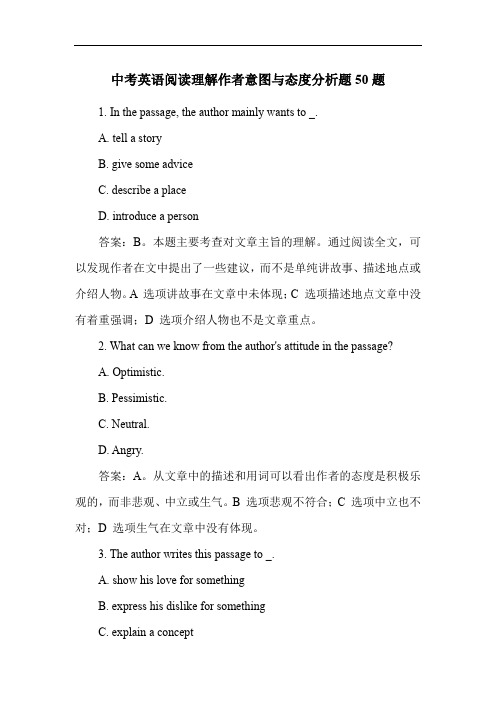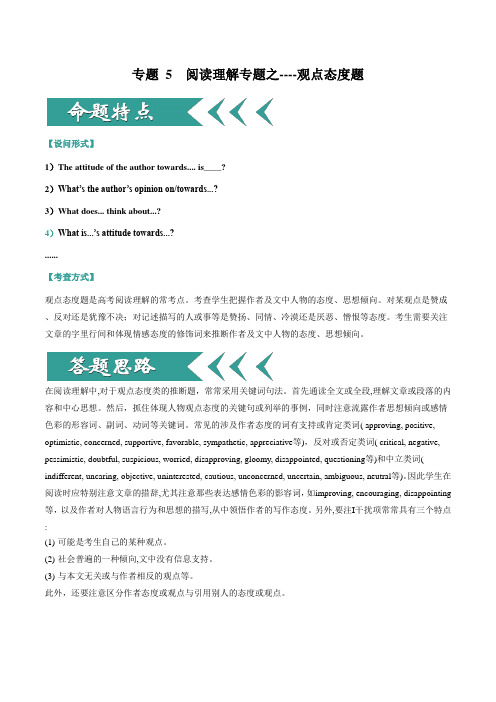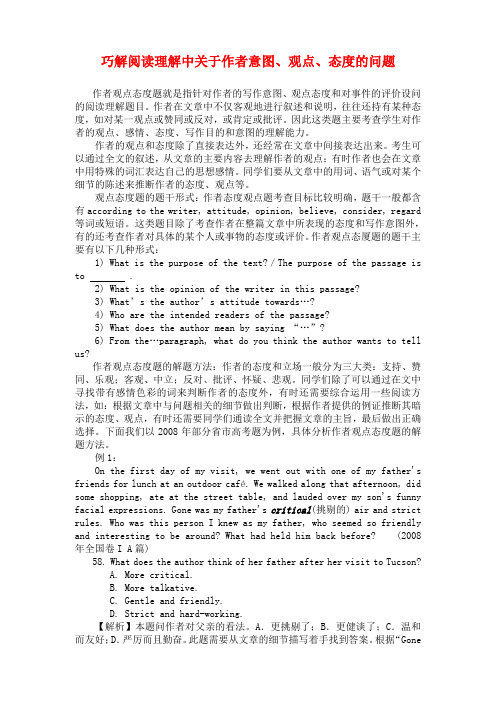英语阅读作者态度题的词汇
- 格式:pdf
- 大小:33.78 KB
- 文档页数:1

中考英语阅读理解作者意图与态度分析题50题1. In the passage, the author mainly wants to _.A. tell a storyB. give some adviceC. describe a placeD. introduce a person答案:B。
本题主要考查对文章主旨的理解。
通过阅读全文,可以发现作者在文中提出了一些建议,而不是单纯讲故事、描述地点或介绍人物。
A 选项讲故事在文章中未体现;C 选项描述地点文章中没有着重强调;D 选项介绍人物也不是文章重点。
2. What can we know from the author's attitude in the passage?A. Optimistic.B. Pessimistic.C. Neutral.D. Angry.答案:A。
从文章中的描述和用词可以看出作者的态度是积极乐观的,而非悲观、中立或生气。
B 选项悲观不符合;C 选项中立也不对;D 选项生气在文章中没有体现。
3. The author writes this passage to _.A. show his love for somethingB. express his dislike for somethingC. explain a conceptD. persuade readers to do something答案:D。
通过对文章内容的分析,可以看出作者的目的是说服读者去做某件事情,而不是单纯表达对某物的喜爱或厌恶,也不是解释一个概念。
A 选项表达喜爱不准确;B 选项表达厌恶不符合;C 选项解释概念不是重点。
4. What is the author's main purpose in writing this passage?A. To amuse readers.B. To inform readers.C. To warn readers.D. To educate readers.答案:B。

专题 5 阅读理解专题之----观点态度题【设问形式】1)The attitude of the author towards.... is____?2)What’s the author’s opinion on/towards...?3)What does... think about...?4)What is...’s attitude towards...?......【考查方式】观点态度题是高考阅读理解的常考点。
考查学生把握作者及文中人物的态度、思想倾向。
对某观点是赞成、反对还是犹豫不决;对记述描写的人或事等是赞扬、同情、冷漠还是厌恶、憎恨等态度。
考生需要关注文章的字里行间和体现情感态度的修饰词来推断作者及文中人物的态度、思想倾向。
在阅读理解中,对于观点态度类的推断题,常常采用关键词句法。
首先通读全文或全段,理解文章或段落的内容和中心思想。
然后,抓住体现人物观点态度的关键句或列举的事例,同时注意流露作者思想倾向或感情色彩的形容词、副词、动词等关键词。
常见的涉及作者态度的词有支持或肯定类词( approving, positive, optimistic, concerned, supportive, favorable, sympathetic, appreciative等),反对或否定类词( critical, negative, pessimistic, doubtful, suspicious, worried, disapproving, gloomy, disappointed, questioning等)和中立类词( indifferent, uncaring, objective, uninterested, cautious, unconcerned, uncertain, ambiguous, neutral等)。
因此学生在阅读时应特别注意文章的措辞,尤其注意那些表达感情色彩的影容词,如improving, encouraging, disappointing 等,以及作者对人物语言行为和思想的措写,从中领悟作者的写作态度。


巧解阅读理解中关于作者意图、观点、态度的问题作者观点态度题就是指针对作者的写作意图、观点态度和对事件的评价设问的阅读理解题目。
作者在文章中不仅客观地进行叙述和说明,往往还持有某种态度,如对某一观点或赞同或反对,或肯定或批评。
因此这类题主要考查学生对作者的观点、感情、态度、写作目的和意图的理解能力。
作者的观点和态度除了直接表达外,还经常在文章中间接表达出来。
考生可以通过全文的叙述,从文章的主要内容去理解作者的观点;有时作者也会在文章中用特殊的词汇表达自己的思想感情。
同学们要从文章中的用词、语气或对某个细节的陈述来推断作者的态度、观点等。
观点态度题的题干形式:作者态度观点题考查目标比较明确,题干一般都含有according to the writer, attitude, opinion, believe, consider, regard 等词或短语。
这类题目除了考查作者在整篇文章中所表现的态度和写作意图外,有的还考查作者对具体的某个人或事物的态度或评价。
作者观点态厦题的题干主要有以下几种形式:1) What is the purpose of the text?/The purpose of the passage is to .2) What is the opinion of the writer in this passage?3) What’s the author’s attitude towards…?4) Who are the intended readers of the passage?5) What does the author mean by saying “…”?6) From the…paragraph, what do you think the author wants to tell us?作者观点态度题的解题方法:作者的态度和立场一般分为三大类:支持、赞同、乐观;客观、中立;反对、批评、怀疑、悲观。

高考英语阅读理解态度题单选题30题1. The author's attitude towards the new law can be described as _____.A. supportiveB. indifferentC. criticalD. ambiguous答案:C。
本题考查作者对新法律的态度。
选项A“supportive”意为支持的,若选此选项则表明作者对新法律持积极肯定态度,但文中作者列举了新法律的诸多弊端,并非支持。
选项B“indifferent”意为漠不关心的,而文中作者有明确的观点和评价,并非漠不关心。
选项C“critical”意为批评的,符合文中作者通过列举问题对新法律进行批判的态度。
选项D“ambiguous”意为模糊不清的,文中作者态度明确,并非模糊不清。
2. What is the attitude of the writer towards the proposed solution?A. OptimisticB. PessimisticC. DoubtfulD. Confident答案:C。
此题考查作者对所提出的解决方案的态度。
选项A“Optimistic”表示乐观的,若选此选项意味着作者认为该解决方案可行且效果良好,但文中作者对其可行性提出了质疑。
选项B“Pessimistic”表示悲观的,然而文中作者并非完全否定该方案,只是存在怀疑。
选项C“Doubtful”意为怀疑的,符合文中作者对方案的态度,作者在文中指出了方案可能存在的问题和不确定性。
选项D“Confident”表示自信的,与文中作者的态度不符。
3. The tone of the passage when referring to the recent development is _____.A. excitedB. cautiousC. enthusiasticD. worried答案:B。

高三英语阅读理解态度观点题单选题30题1. In the conversation, the man says, "I think it's a brilliant idea." What is his attitude towards the idea?A. PositiveB. NegativeC. NeutralD. Doubtful答案:A。
解析:“brilliant”表示出色的、杰出的,男人说“这是个出色的主意”,表明他对这个主意持积极肯定的态度,所以选 A 选项。
B 选项“Negative”表示消极的;C 选项“Neutral”表示中立的;D 选项“Doubtful”表示怀疑的,均不符合男人的表述。
2. The woman responds, "I'm not so sure about that." What is her attitude?A. ConfidentB. UncertainC. OptimisticD. Enthusiastic答案:B。
解析:“not so sure”意思是不太确定,表明女人的态度是不确定的,所以选B 选项。
A 选项“Confident”表示自信的;C 选项“Optimistic”表示乐观的;D 选项“Enthusiastic”表示热情的,都不符合女人的回应。
3. The boy says, "I completely disagree." What is his stance?A. AgreeableB. OpposedC. IndifferentD. Hesitant答案:B。
解析:“completely disagree”意思是完全不同意,这表明男孩的立场是反对的,所以选B 选项。
A 选项“Agreeable”表示同意的;C 选项“Indifferent”表示漠不关心的;D 选项“Hesitant”表示犹豫的,均不符合男孩的表述。
专题二主旨、要义、作者的意图、观点和态度类题目[命题特点]针对文章的主要内容、中心思想、段落大意以及文章的标题进行设问。
(1)设题关键词:①general idea/main idea/mainly tells...②main meaning/attitude towards...③intention/intend to.../tend to.../have a tendency...(2)设题切入点:从文章中的名词、动词、形容词、副词可推断作者的意图与态度。
态度、观点、赞同的关键词:approval/approve/be in favour of,argue,believe,suppose,think,be convinced that...[考查重点](1)对文章的归纳总结能力。
(2)对标题关键词的提炼能力。
[方法技巧](1)利用信息词(如all in all,in a word,there-fore,It shows...等)确定主题句、总结句的位置。
(2)对于主题隐含的段落,先弄清问题的意思,然后快速通读全文,逐项排除,确定主旨。
(3)记叙文:“何人何时何地何法干何事”。
(4)议论文:多在首段或尾段。
(5)夹叙夹议:多在尾段。
Passage 1Over 70 percent of the “double single-child couples”in China need help from their parents in taking care of their own kids, according to a recent survey.Women of China magazine and a consulting company carried out a survey recently on young couples of the “single-child”generation, the Morning Post reports. The couples surveyed were around 29 and have been married for three years on average, with university education and monthly income of 4,000 yuan($531). Among them, 43.5 percent have kids.Results show that 71.9 percent of the young couples have help from their parents in taking care of their kids.Grown up as the “single-child”,the only child in a family since the family planning policy which was adopted in 1979, this generation depends much on their parents.The parents of the “single-child” generation focused more on their children's physical well-being rather than their attitudes and values, according to some psychologists.The research also found that the “double single-child couples” follow a rather traditional value system.Survey shows that 27.5 percent of them got married after dating for one to two years, 25.2 percent two to five years, and 20 percent didn't tie the knot until dating for five years. Also, 30 percent of the couples were schoolmates, while 43.8 percent were introduced bysomeone.Since their marriage is based on enduring relationships, 65.2 percent of the husbands and 62.9 percent of the wives think that compromise(妥协)and tolerance(宽容) are necessary in their marriage. Meanwhile, 21.7 percent of the husbands and 37.1 percent of the wives support the idea that happiness is the key standard for a marriage.【语篇解读】本文主要介绍了让父母照顾孩子的社会现象。
英语阅读理解高频考点——写作意图题巧突破作者的意图、观点和态度题考生具有较高层次的阅读技能,包括在复杂的语境条件下把握作者的思路,在较高深的措辞中探索作者隐藏的思想及真正的写作意图。
常见的意图、观点和态度题考查考生对文章的写作意图和作者及文中人物的主观态度的把握以及分析作者描述某些细节的意图的能力。
此类题属于得分率较低的高难度题。
近三年写作意图题/观点态度题考查频次一览表时间从上表可以看出,近年来全国卷中此类题的考查频次有所增加。
预计2019年高考仍然会有1—2道考查写作意图或观点态度的题,考生备考时要重视起来。
考点1写作意图题此类题型要求考生根据文章的论述,推测作者的写作意图及应用某种写作手法的目的。
作者一般不直接陈述自己的意图,而是通过文章所提供的客观事实使读者信服某种想法或观点。
这类题型要求考生不仅能理解文章的内容,还要具备对作者所阐述的问题及使用的写作手法进行分析和归纳总结的能力。
整篇文章的写作意图的常见设问方式有:For what purpose did the author write the passage?The writer writes this passage in order to .The purpose of the text is to .某处细节的写作目的的常见设问方式有:What is the purpose of the last part of the text?The writer uses...in the first paragraph to .The writer uses the example of...to .【典例1】(2019·北京卷·C篇)Measles(麻疹), which once killed 450 children each year and disabled even more, was nearly wiped out in the United States 14 years ago by the universal use of the MMR vaccine(疫苗). But the disease is making a comeback, caused by a growing anti\|vaccine movement and misinformation that is spreading quickly. Already this year, 115 measles cases have been reported in the USA,compared with 189 for all of last year.The numbers might sound small, but they are the leading edge of a dangerous trend. When vaccination rates are very high, as they still are in the nation as a whole, everyone is protected. This is called "herd immunity", which protects the people who get hurt easily, including those who can t be vaccinated for medical reasons, babies too young to get vaccinated and people on whom the vaccine doesn t work.But herd immunity works only when nearly the whole herd joins in. When some refuse vaccination and seek a free ride, immunity breaks down and everyone is in even bigger danger.That s exactly what is happening in small neighborhoods around the country from Orange County, California, where 22 measles cases were reported this month, to Brooklyn, N.Y., where a 17\|year\|old caused an outbreak last year.The resistance to vaccine has continued for decades, and it is driven by a real but very small risk. Those who refuse to take that risk selfishly make others suffer.Making things worse are state laws that make it too easy to opt out(决定不参加) of what are supposed to be required vaccines for all children entering kindergarten. Seventeen states allow parents to get an exemption(豁免), sometimes just by signing a paper saying they personally object to a vaccine.Now, several states are moving to tighten laws by adding new regulations for opting out. But no one does enough to limit exemptions.Parents ought to be able to opt out only for limited medical or religious reasons. But personal opinions? Not good enough. Everyone enjoys the life\|saving benefits vaccines provide, but they ll exist only as long as everyone shares in the risks.66.What is the purpose of the passage?A. To introduce the idea of exemption.B. To discuss methods to cure measles.C. To stress the importance of vaccination.D. To appeal for equal rights in medical treatment.【解析】这是一篇说明文。
阅读理解之观点态度题概述观点态度题是高考英语阅读常考的一种题型,也是考生很容易失分的一种题型。
这种题型有时问作者对某事持什么态度,有时问他人对某事持什么态度。
所以大家解答这类题型时,思维一定要清晰,要注意看这道题是说谁的态度,关于哪一个话题,在文章中是怎样表现的。
一、注意事项1.根据文章主题句来判断。
文章的中心思想与作者的观点态度是密切相关的,而文章的主题句又反映了文章的中心思想,因此,可通过文章的主题句来判断作者的观点态度。
2.注意不要将个人的好恶态度糅进题中,要学会分清作者本人的态度和作者引用观点的态度。
3.要学会根据作者语言的褒贬去判断作者的态度。
注意句中带有感情色彩的副词:如wonderfully,successfully,unfortunately,doubtfully等。
4.一般来说,作者的态度不可能是漠不关心的,因此见到indifferent,uninterested通常可以排除。
5.作者的态度常常在转折词后表明出来,所以见到but就要提高警惕(还有类似的yet,however,although,nevertheless等)。
6.可以通过作者所举的例子,来判断文章作者的态度倾向。
作者论证某观点时,给的例子是正面的,就可以判断作者的态度是积极乐观的;如果作者的论述有好有坏,举例有正面有反面,基本可以判断作者的态度是客观的。
二、感情色彩常用词归纳1.表示贬义的常用词:negative,critical,ambiguous,disapproving,doubtful等。
2.表示褒义的常用词:positive,support,favorable,sympathetic,helpful,cautious,enthusiastic,admiring等。
3.表示中立的常用词:indifferent,neutral,objective等。
[示例1]Friedman points out that the green economy (经济) is a chance to keep American strength.“The ability to design,build and export green technologies for producing clean water,clean air and healthy and abundant food is going to be the currency of power in the new century.”30.What is Friedman’s attitude towards America’s future?A.Ambiguous.B.Doubtful.C.Hopeful.D.Tolerant.分析:根据最后一段第一句“Friedman points out that the green economy (经济) is a chance to keep American strength.”可知,Friedman 认为绿色经济是使美国保持实力的一个机遇。
九年级英语阅读理解态度观点题单选题40题1. In the passage, the author's attitude towards the new technology is _____.A.enthusiasticB.cautiousC.indifferentD.negative答案:B。
本题主要考查对作者态度的判断。
A 选项“enthusiastic”表示热情的,文章中并没有体现出作者对新技术的热情;C 选项“indifferent”表示冷漠的,文中作者有对新技术进行思考,并非冷漠;D 选项“negative”表示消极的,文章中也没有明确的消极态度表达。
B 选项“cautious”谨慎的,符合文章中作者对新技术既看到其好处又考虑到可能存在的问题的态度。
2. What is the main character's opinion on the school trip?A.excitingB.boringC.tiringD.meaningful答案:D。
A 选项“exciting”表示令人兴奋的,但文中没有突出旅行令人兴奋的描述;B 选项“boring”表示无聊的,与文章中对学校旅行的描述不符;C 选项“tiring”表示累人的,文中虽提到有点累,但重点强调了旅行的意义。
D 选项“meaningful”有意义的,符合文章中主人公从旅行中收获很多感悟的态度。
3. The writer's attitude towards environmental protection is _____.A.supportiveB.doubtfulC.opposedD.unconcerned答案:A。
B 选项“doubtful”表示怀疑的,文章中明确表达了对环保的积极行动,不是怀疑态度;C 选项“opposed”表示反对的,与文章主旨相悖;D 选项“unconcerned”表示不关心的,不符合文章中对环保的重视。
作者态度题的词汇
• 不选的词汇:
• 迷惑的: p uzzled=puzzling=confused=confusing
• 放纵:indulgence=permissive
• 宽容,容忍: t olerance=tolerant
• 绝望的:desperate=despair=gloomy
• 自负的: c onceited=arrogant
• 有偏见的: b iased=prejudiced
• 不选的词汇:
• 模糊的ambiguous=obscure=vague=vagueness=uncertain=uncertainty
• 鄙视;讽刺:contempt=contemptuous= s arcastic=irony=satire
• 冷漠: i ndifference=indifferent; uninterested
• 不重要的;琐碎的: t rivial
• 破坏性的=destructive
• 害怕:scared=scary=terrific=panicked
• 主观的:subjective 敏感的:sensitive
• 无忧无虑的:carefree
• 肯定/赞同/支持
• 1.肯定;积极的;乐观:
• positive; o ptimistic; o ptimism(乐观)
• 2.支持,赞同的:
• full a pproval; approval; appreciative;appreciation; sympathy;
sympathetic;supportive; favorable;enthusiasm, e nthusiastic • 3.满意:
• satisfaction;satisfactory;desirable;soothing(令人欣慰的)
• 作者的态度(否定、怀疑、不赞同)
• 否定;悲观
• negative; p essimistic; p essimism(悲观);
• 不赞同;反对;怀疑:
• disapproval(不赞同);objection(反对);opposition(反对) Skeptical;
skepticism ; doubtful;dubious;suspicion;suspicious;suspect;
questionable
• 批判:critical;criticism 有害的:harmful
• 愤怒:Indignant 焦虑:Apprehensive.
• 作者的态度(中立,客观)
• objectiveness客观;impartial公正的;
• neutral(中立的);unbiased(没有偏见的);detached(超然的)。